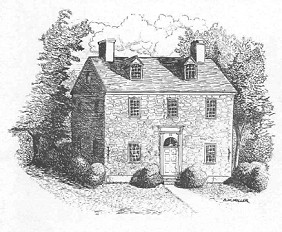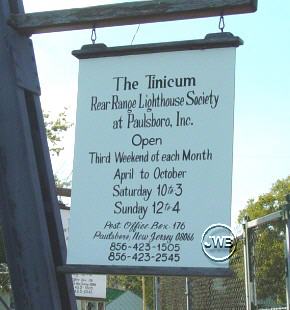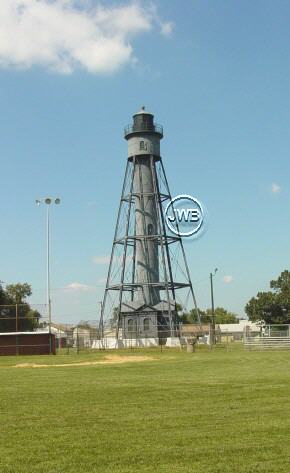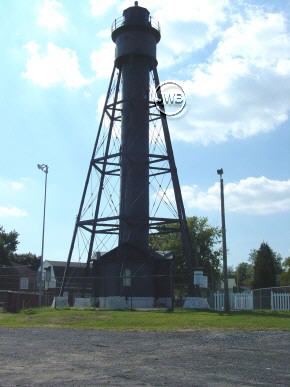
P A U L S B O R O & B I L L I N G S P O R T

History abstracted from several sources including:
1) "A Look at Old Paulsboro," by the Paulsboro Tercentenary Committee, 1964
2) "Under Four Flags, Old Gloucester County," Hazel B. Simpson, editor; Camden., NJ 1976
PAULSBORO & BILLINGSPORT 1664-1964
AREA EARLY HISTORY
Paulsboro, New Jersey is an industrial town located on the Delaware River across from Philadelphia. It is bound by the Delaware River on the north, the Mantua Creek on the east, Greenwich Township on the west, and East Greenwich Township on the south. 1904 is considered the beginning date for Paulsboro, but its history actually begins with the Leni Lenape Native Americans who inhabited the area then known as Crown Point, before the white men arrived.
The first white settlement on the Delaware was made in 1623 when Captain Cornelius Mey sailed to the mouth of Big Timber Creek. His men established Fort Nassau.
For information regarding the early Swedish settlement of the Delaware, refer to information on the Swedish Colonial web site.
King Charles of England, in 1664, granted the land from the Delaware River to Connecticut, to his brother, and Lord Berkeley became the proprietor of West Jersey. In 1672, after much dispute among the settlers, the land was given to England. Settlers came and a yearly rent was charged. West Jersey progressed slowly and Lord Berkeley sold part of the land to John Fenwick and Edward Byllings. There was a dispute over the division and William Penn was called in to settle the disagreement by setting the boundaries. Byllings was awarded the land between Oldman's Creek and Timber Creek to the river. Paulsboro just missed becoming a part of Penn's Philadelphia in this division. The deed was recorded on September 22, 1677. Two hundred and thirty settlers who came with Penn and Byllings bought land for one penny an acre. The place was named Byllings Port, now Billingsport. Penn stated that this land would never become a great industrial center because it was an island with a swamp on one side and a creek on the other.
EARLY DAYS OF THE TOWNSHIP
In 1686 Gloucester County was formed. Greenwich Township became the first township. It was incorporated on March 1, 1694.
[NOTE: There are documents which indicate that the Paul family may have originated in Stocklinch, Somerset Co., England, and not Scotland. If you are a descendant of this line, or a researcher of the Paul Family, realize the following paragraph is taken from a history about Paulsboro and may not be accurate]. On September 5, 1685, John, Philip, and Joel Paul left Edinburg, Scotland for America. After a ten year stay in Virginia, Joel settled in Pennsylvania, and Philip and John settled near Mantua Creek. Samuel P. Paul, son of Philip bought a 100 acre tract of land bound by the Delaware River on the north and the Mantua Creek on the east.
In 1764 England claimed all of New Jersey. When the English took possession, they found many Swedes living in the area. The Swedish name for Billingsport was Manta's Hook, and it was a shad fishing center. The homes of the Swedes were built of logs, chinked with clay, and were one story dwellings, consisting of one room. The doors were so low that one had to stoop to enter. The windows were holes cut in the logs with sliding boards to cover them. The men and women dressed in animal skins. Their shoes were of skins which they dyed red with berries. They brought horses, cows, sheep, hogs and seed with them from Sweden. They kept many national customs and every Saturday night they bathed in the creek.
PAULSBORO DURING THE AMERICAN REVOLUTION
On July 5, 1776 Margaret Paul, widow of John Paul, and her son Benjamin Weatherby, sold 96 acres of Billingsport for 600 pounds of Pennsylvania currency to the Council of Safety of Philadelphia. The land was charged to Congress. This was the first piece of land bought by our federal government.
In 1777 a redoubt and fort were erected at Billingsport by troops from Virginia, Pennsylvania, South Carolina, and New Jersey in accordance with plans prepared by the Polish patriot Kosciuszko. Part of a defense system established for the lower river, the purpose of this fort was to build and maintain the chevaux-de-frise on the Delaware to prevent the entrance of the British to Philadelphia. The chevaux-de-frise were made of poles from 30-40 feet in length. On the point of each stick was fastened a long, sharp pierce of iron for piercing the bottom of any vessel which passed over it.
The defense system consisted of the fortification of strategic points on both sides of the river, a chain of alarm guns from the Capes to Philadelphia, the chevaux-de-frise, and a navy of vessels, from armed row-galleys to seagoing ships. Two posts were erected on the New Jersey side of the river. The other post was Fort Mercer at Red Bank.
On August 1, 1777 the fort was inspected by George Washington and Lafayette and the men were commended by them for their work. Washington had moved his men from Morristown to Philadelphia at the time because he had learned that Admiral chow's fleet had sailed from Sandy Hook, a spot then controlled by the British, and were headed to Philadelphia. Lord Howe did sail up the Delaware, but he was stopped at Billingsport by the naval stockade. The outnumbered Americans later burned their barracks here and went to Red Bank. Billingsport was the tenth alarm post on the Delaware, equipped with a small cannon which warned other posts of the arrival of enemy ships. The fort was briefly occupied by the enemy, bit it was evacuated in 1777.
WAR OF 1812 & BILLINGSPORT
The fort was again occupied by American troops in the War of 1812. The "Blues of Gloucester County," a volunteer infantry regiment, was recruited on August 27, 1814 the day news arrived that British had burned some public buildings in Washington. Randall Sparks led this group. As late as September 17, 1814, Billingsport's fort was still in use, as on that date, General Elmer's Brigade assembled at Billingsport, together with some of the officers and men, commanded by General Franklin Davenport. They were stationed at Billingsport for three or more months. After peace was declared, the fort was deserted and forgotten.
A monument was erected many years later by the Esso Oil Company (later known as the Humble Oil and Refining Company), to mark the site of this fort.
EARLY 1800's
Between 1700 and 1800 settlers came into the area and spread settlements over the county. Records show that Gloucester County was governed at this time by representatives for the township called justices who seemed to act as court judges and freeholders. In 1800 Paulsboro was still called Crown Point. It then consisted of a stone farm house occupied by Samuel Paul, who owned property from the creek to Delaware Street. Below Delaware Street was owned by Henry Myers. Paul's land along the Delaware was called Paul's Fishing Place. In 1805 the Paul family owned half of the town.
In 1811 there were three houses, two stores and two shoemakers in the town. In 1798 Mr. Paul sold two acres of land to Michael Loudenslager who, in 1804, built a tavern on the corner of Commerce and Broad Streets. That was the second house in town. There was no road along Broad Street, although one had been surveyed, so Mr. Loudenslager closed his hotel until 1809 when the turnpike, a toll road, of which Broad Street was a part, was built. The third house in Paulsboro was built in 1811 by John Bowers.
John Benus, the first shoemaker, opened his business in 1811. The first postmaster was Jacob Price in 1844. In 1812 a small bridge was built across the creek. Before this time the creek was crossed by a boat. The first schoolhouse was built in 1820. Benjamin Lodge, the first schoolmaster, dispensed learning and hickory oil for three cents a day. In 1825 Dr. Charles Clark, the first physician, came to town. Thomas Ware was the first preacher in Crown Point. The first religious meeting was held in 1825 in the schoolhouse. The Methodist Church was incorporated in 1827 with twelve members. The first church was built of stone in 1838, Samuel Paul, for whom the town was named, gave the land adjoining the church for a burial ground. He was the first to be buried in the new cemetery.
MID 1800s
In 1858 the population had increased to 450. A hotel was built on Main Street and another school was built at Buck Street. The streets after the school were named Washington, Adams, Jefferson, Madison, and Monroe.
The county became involved with the Civil War at this time, Paulsboro was also involved because it sent young volunteers to serve in Company E., 24th Regiment of New Jersey. Paulsboro has seen no action in any war since the Revolution, but it has sent its young men to serve our cause on distant soil.
New churches were formed during this time. The Presbyterian Church began in 1868. The St. James Episcopal Church was built in 1873.
Before this time the main means of transportation has been by boat on the rivers. In 1876 the railroad entered Paulsboro. It was a private company called the Delaware-Shore Line. After suffering financially, it was taken over by the DuPont Company and called the Delaware River Railroad. It later became part of the Pennsylvania Railroad. As in other areas, the coming of the railroad spurred business and settlement in Paulsboro.
LATE 1800s
Around 1880 the government decided that Billingsport was an excellent location for a lighthouse and one was built there (The Tinicum Rear Range Light House station - SEE BELOW) on an elevated point a short distance from the old Billingsport fort. The government named Benjamin Hannold the first lightkeeper. This lighthouse was automated in 1967.
In 1880, Coe and Richman bought a farm of 120 acres from Samuel Davis and built one of the largest phosphate works in the United States at that time. Later I.P. Thomas and Sons, Co., owned the works and they made and sold fertilizers and insecticides for farm and home use.
The All-Thompson baseball team brought fame to the town around this time. It was the first all brother baseball team in the world and all of its members lived in Paulsboro. They began with no uniforms and no equipment. The catcher caught with his bare hands. The team played the Cuban Stars in Gloucester and offered a challenge to any team in the world composed of all brothers. They gave exhibition games at the Chicago World's Fair.
In 1890 St. John's Roman Catholic Church began. In the same year Lincoln Park was built by Robert Patterson. It was situated on a 28 acre plot along the river. Formally opened on June 14, 1890, it was an amusement park with concerts and fireworks every two weeks. It was the only place for entertainment at that time because the automobile was not yet in use and a resort close to home and to available transportation was necessary. People came from all over to swim, hold picnics, and enjoy the amusements. The park attracted large crowds from Philadelphia. It was particularly famous for its carousel and was kept orderly by Captain Linden of the Pinkerton Detective Agency. "The Jersey Blue," a ferry, handled the river traffic between Philadelphia and Billingsport.
In 1892 the Methodist Episcopal Church was begun. The Taylor Memorial Baptist Church started in 1897. The first fire company was organized on April 14, 1899 and was incorporated in 1900. The first piece of equipment was purchased and kept in Armstrong's Livery Stable. When the alarm rang, Mr. Armstrong provided the horses for the company.
EARLY 1900s
Lincoln Park was now at its height. Sixteen trains brought many passengers from the Philadelphia-Camden area to Billingsport daily. Two ferries and five steamboats made the trip across the river daily. The Public Library was started in 1900. The First National Bank and Trust Company began on May 25, 1901. Capital stock was $30,000. Benjamin Paul was the first president.
On March 2, 1904 Paulsboro and Billingsport, previously part of Greenwich Township, were incorporated as the Borough of Paulsboro, taking the name from Samuel Paul. Gill Hannold was the first mayor.
Lincoln Park had lost its popularity and had closed. It opened a second time, but was unsuccessful due to the advent of the automobile, which now enabled people to travel, and again closed, this time for good. Summer homes were built along the Delaware and occupied by people mainly from Philadelphia. These were small resort homes on the shore and they provided summer relaxation, swimming and boating for their occupants.
In 1904 the Billingsport Volunteer Fire Company began three days after the serious fire which totally destroyed the Billingsport and Philadelphia Ferry Co. on the morning of October 5, 1904. Samuel De Binder, a Philadelphia businessman who had a summer home in Billingsport, called a meeting at his residence on October 8 to organized and initiate a permanent organization to be known as the Billingsport Volunteer Fire Association. The meeting was attended by fifteen men.
Future meetings were held in members' homes until the hall over the store of Wm. H. Flowers was secured for meetings. In 1905 the company received a two-wheel hose reel and 500 feet of hose, the beginning of Billingsport's fire fighting equipment. Due to the need to store this equipment, a five year lease was obtained on what was called Cinnelly's Shop, a one story frame building at the entrance to Lincoln Park. The company was incorporated on May 14, 1905.
In 1906 the Second Baptist Church, composed of a negro congregation was built. A gas plant was also built that year which supplied gas to Paulsboro until 1953.
Just before World War I, the export business of Vacuum Oil required a refinery on the east coast. A location near Paulsboro seemed most suitable and Vacuum purchased it in April 1916. The Paulsboro plant, which began in 1917, was designed to manufacture lubricating oil. Gasoline and kerosene were considered by-products. Mobil, the plant's name [in 1964], is actually located in Gibbstown and it pays its taxes to that municipality. (Penn's boundary places it a few feet from the Paulsboro boundary), but it is referred to as the Paulsboro plant and most of its employees live in Paulsboro.
Mobil also operates [1964] a research laborator here. Some of the great advances in petroleum processing were first used commercially at the Paulsboro refinery. The first continuous two-stage fractioning unit was built in 1928. The first Duo-Sol unit for continuous treating of lubricating oil stock was put into service in 1936. In this year the first commercial catalytic cracking unti was also put into operation. The main products of Mobil are lubricating oil, gasoline, and motor oil.
Paulsboro was now changing from a residential to an industrial town. The first movie was shown on the second floor of the Bailey Building. Movies were shown in the "Auditorium" twice a week. Friday was dance night and the young men brought in girls from the surrounding areas because there was a shortage of girls in town. A law was passed stating that movies weren't allowed on the second floor and Mr. Bailey built a movie house which opened to the public in 1916. The first principal was a Mr. Burns. In 1918 Mr. Hill bought the movie house from Bailey and named it the "Hill." On April 12, 1921 money was appropriated to build a system of drainage and sewage disposal. In 1924 the Billingsport Grade School, with fourteen rooms, was built. It accomodated 438 pupils and fourteen teachers. In this year Paulsboro bought and began to operate the water company. Mail delivery was begun on July 1 of that year. In 1928 the Atlantic City Electric Company began to operated in town. Electricity had previously been supplied by the Boro. In 1930 the population of Paulsboro was 7, 121.
In 1935 the present bridge crossing Mantua Creek was built because the former bridge, due to increased traffic, proved to be too narrow. Mr. Hill built a new movie theatre and the old theatre became known as the Boro. In 1939 the government built a new federal post office. Located on the Delaware and Adams Streets, the building was dedicated on November 24, 1939.
1950s AND BEYOND
The population in 1950 was 7,840. The First National Bank and Trust Company celebrated its 50th anniversary in 1951. In 1953 the gas plant was sold and the South Jersey Gas Company in Glassboro began to supply Paulsboro with natural gas.
The Library name was changed from the Paulsboro Free Library to the Gill Memorial Library at the dedication opening on July 7, 1951 with Irma C. Lodge as its first Librarian.
[In 1964] Paulsboro has many churches. There is one Catholic church, three Methodist, two Baptist, one Presbyterian, one Episcopal, one Bethel A.M.E., one Mt. Carmel U.A.M.E., and a Kingdom Hall of Jehovah's Witnesses. There were two elementary schools, and a junior-senior high school. There was also a Catholic school which includes grades one through eight.
Valero Energy Corp. purchased Mobil's Paulsboro, N.J., refinery in 1998.
In 1990, there were 6,577 people living in Paulsboro, and as of the census of 2000, there are 6,160 people, 2,353 households, and 1,614 families residing in the borough
Paulsboro has several businesses and many stores. It is located on Route #130 and #295 goes through the outskirts of town. It is connected to Philadelphia and other towns in New Jersey by bus, train, and water. There are now two volunteer fire companies with modern equipment serving the community. Paulsboro is governed by a mayor and council.
An industrial town, Paulsboro is located in a prime industrial and cultural area because of its proximity to the Delaware River and to Philadelphia. Paulsboro is looking forward toward the future.
OLD HOUSES
The two oldest houses in Paulsboro are the "Paul House" (built about 1810) and the Gill Library (built for Matthew Gill in 1806).
PROFILE OF PAULSBORO, NEW JERSEY
- Demographics of Paulsboro, N.J.
- Houses of Worship in Paulsboro, N.J. - from Church Angel
- 1997 Business Data
=====================================================
P H O T O G R A P H S
Some photographs from booklet: "A Look at Old Paulsboro," by the Paulsboro Tercentenary Committee, along with links to old postcards and photographs.
Photographs of Gill Memorial Library & Museum in Paulsboro, New Jersey (taken June 2006) Please do not use without permission of webmaster Tinicum Rear Range Light House
The Tinicum Rear Range Light House station was established in 1880, and was automated in 1967. The foundation is made of stone, with the remainer of iron. It stands 86 feet high. [The posted sign says: "Open Third Weekend of each Month, April to October (Saturday 10 to 3; Sunday 12 to 4)."
[Next to the Paulsboro Little League Ball Field]
Call 856-423-1505
or 856-423-2545- Tinicum Light Station - National Park Service
- Tinicum Lighthouse - Lighthouse Friends
Reference | Photographs | Contact | Site Map
Copyright © 2003-2020 | Janice A. Brown | All rights reserved.































